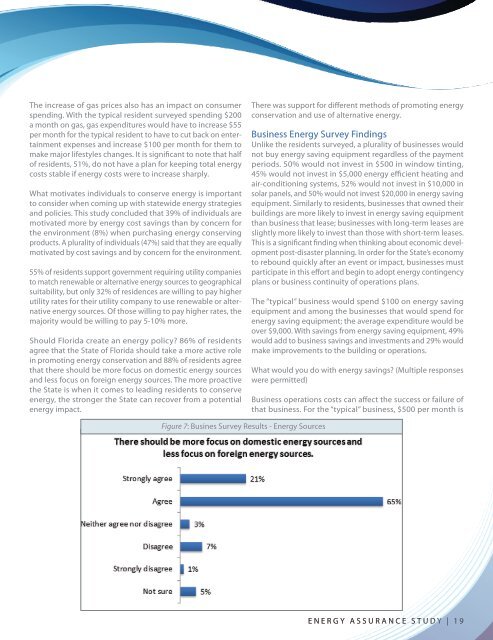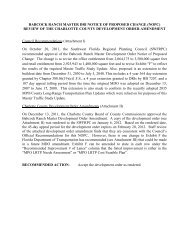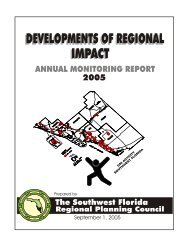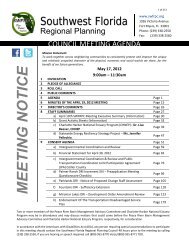Energy Assurance Study: Interim Report - Southwest Florida ...
Energy Assurance Study: Interim Report - Southwest Florida ...
Energy Assurance Study: Interim Report - Southwest Florida ...
- No tags were found...
You also want an ePaper? Increase the reach of your titles
YUMPU automatically turns print PDFs into web optimized ePapers that Google loves.
The increase of gas prices also has an impact on consumerspending. With the typical resident surveyed spending $200a month on gas, gas expenditures would have to increase $55per month for the typical resident to have to cut back on entertainmentexpenses and increase $100 per month for them tomake major lifestyles changes. It is significant to note that halfof residents, 51%, do not have a plan for keeping total energycosts stable if energy costs were to increase sharply.What motivates individuals to conserve energy is importantto consider when coming up with statewide energy strategiesand policies. This study concluded that 39% of individuals aremotivated more by energy cost savings than by concern forthe environment (8%) when purchasing energy conservingproducts. A plurality of individuals (47%) said that they are equallymotivated by cost savings and by concern for the environment.55% of residents support government requiring utility companiesto match renewable or alternative energy sources to geographicalsuitability, but only 32% of residences are willing to pay higherutility rates for their utility company to use renewable or alternativeenergy sources. Of those willing to pay higher rates, themajority would be willing to pay 5-10% more.Should <strong>Florida</strong> create an energy policy? 86% of residentsagree that the State of <strong>Florida</strong> should take a more active rolein promoting energy conservation and 88% of residents agreethat there should be more focus on domestic energy sourcesand less focus on foreign energy sources. The more proactivethe State is when it comes to leading residents to conserveenergy, the stronger the State can recover from a potentialenergy impact.There was support for different methods of promoting energyconservation and use of alternative energy.Business <strong>Energy</strong> Survey FindingsUnlike the residents surveyed, a plurality of businesses wouldnot buy energy saving equipment regardless of the paymentperiods. 50% would not invest in $500 in window tinting,45% would not invest in $5,000 energy efficient heating andair-conditioning systems, 52% would not invest in $10,000 insolar panels, and 50% would not invest $20,000 in energy savingequipment. Similarly to residents, businesses that owned theirbuildings are more likely to invest in energy saving equipmentthan business that lease; businesses with long-term leases areslightly more likely to invest than those with short-term leases.This is a significant finding when thinking about economic developmentpost-disaster planning. In order for the State’s economyto rebound quickly after an event or impact, businesses mustparticipate in this effort and begin to adopt energy contingencyplans or business continuity of operations plans.The “typical” business would spend $100 on energy savingequipment and among the businesses that would spend forenergy saving equipment; the average expenditure would beover $9,000. With savings from energy saving equipment, 49%would add to business savings and investments and 29% wouldmake improvements to the building or operations.What would you do with energy savings? (Multiple responseswere permitted)Business operations costs can affect the success or failure ofthat business. For the “typical” business, $500 per month isFigure 7: Busines Survey Results - <strong>Energy</strong> SourcesENERGY ASSURANCE STUDY | 19









